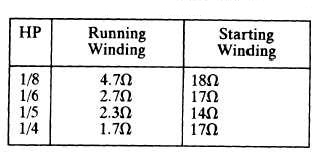winding is short. The pulling effect of the shorted portion of the winding is lost. This, in turn, places more load on the active winding, causing the motor to draw higher voltage and amperage with a concurrent increase in winding temperature. In this condition the motor either fails to start, or it starts and continues to run, finally causing the overload protector to open. The fuses may also blow. The result is likely to be a burnout where the insulating varnish deteriorates from excessive heat. Ultimately a ground or short occurs.
An ohmmeter can be used to check windings for shorts. For most applications a low-range meter with a scale graduated in tenths of ohms between 0 and 2 ohms is best. However, to check motors throughout the sizes normally encountered in hermetic motor-compressor units, a range of 0 to 25 ohms is necessary. The meter is used to measure resistance of the windings. The readings are compared with design resistances. A short is shown when measured resistance is less than design resistance. The ohmmeter connections are the same as those shown in figure 14-30.
Often manufacturer's data is not available and the design resistances are not known. Table 14-1 lists the approximate resistances for fractional horsepower single-phase motors. The following guidelines may also be helpful:
1. The starting winding of low-starting torque motors usually has a resistance of about seven to eight times that of the running winding.
2. The starting winding resistance of high- starting torque motors is usually three to four times that of the running winding.
GROUNDED WINDINGS
A ground is the result of an electrical conductor in contact, either directly or indirectly, with the motor frame or the metal
Table 14-1. - Approximate Resistances for Fractional Horsepower Motor Windings

shell of the unit. Either the starting winding, the running winding, or both can be affected. The ground is either one of low resistance or one of high resistance. A low-resistance ground is indicated when fuses blow repeatedly and the motor fails to start. A high-resistance ground is shown by an occasional blown fuse, but more often, by the opening of the overload protector.
Three methods of testing windings for grounds are the ohmmeter continuity test, the test lamp continuity check, and the resistance measurement with a megohmmeter. The procedure to follow in making each of these tests is provided below.
Ohmmeter Continuity Test (Low-Resistance) Procedure
To perform an ohmmeter continuity test, proceed as follows:
Disconnect the power and remove the wires from the motor terminals.
Scrape off paint and clean a spot on the motor-compressor shell for testing.

Figure 14-33. - Testing windings for ground with an ohmmeter.
Continue Reading